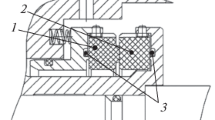Abstract
The ferrohydrodynamic problem, with a disconnected free surface, of the stability of an annular magneto-fluid seal under the action of centrifugal forces and a pressure drop is solved numerically. The effect of the shaft speed on the critical pressure drop is investigated in relation to the volume of the magneto-fluid plug, the magnetic field strength, the magnetic properties of the fluid, the gap width, and the shaft radius. The flow pattern and the thermal power released in the sealing layer are studied.
Similar content being viewed by others
REFERENCES
V. G. Bashtovoi, M. S. Krakov, and S. G. Pogirnitskaya, “Numerical investigation of the heat release power in a magneto-fluid seal with allowance for geometric factors,” Magnitn. Gidrodinamika, No. 2, 116-121 (1991).
B. M. Berkovsky, M. S. Krakov, and S. G. Pogirnitskaya, “Influence of axisymmetric flow structure on energy dissipation in a ring-shaped layer of magnetic fluid,” J. Magnetism and Magnetic Mat., 149, No. 1-2, 101-103 (1995).
L. P. Orlov, V. K. Polevikov, and V. E. Fertman, “Theoretical investigation of thermohydrodynamic processes in a magneto-fluid seal,” Trenie i Iznos, 3, No. 1, 123-128 (1982).
B. M. Berkovsky, V. F. Medvedev, and M. S. Krakov, Magnetic Fluids [in Russian], Khimiya, Moscow (1989).
A. M. Budnik and V. K. Polevikov, “Modeling of the free surface of annular magneto-fluid seals based on the finite element method,” Differents. Uravneniya, 28, No. 7, 1177-1181 (1992).
A. N. Vislovich and V. K. Polevikov, “Effect of the centrifugal and capillary forces on the shape of the free surface of a magneto-fluid seal,” Magnitn. Gidrodinamika, No. 1, 77-86 (1994).
A. N. Vislovich and V. K. Polevikov, “Numerical simulation of the destruction of a magneto-fluid seal with a rotating outer profiled cylinder,” Inzh.-Fiz. Zhurn., 70, No. 1, 105-110 (1997).
V. K. Polevikov, “Stability of a static magneto-fluid seal under the action of an external pressure drop,” Izv. Ros. Akad. Nauk, Mekh. Zhidk. Gaza, No. 3, 170-175 (1997).
L. D. Landau and E. M. Lifshits, Hydrodynamics [in Russian], Nauka, Moscow (1986).
C. A. Brebbia, J. C. F. Telles, and L. C. Wrobel, Boundary Element Techniques, Springer, Berlin (1984).
M. S. Krakov, V. K. Rakhuba, and V. B. Samoilov, “Limiting efficiency of a traditional magneto-fluid sealing system,” Magnitn. Gidrodinamika, No. 1, 140-142 (1981).
Rights and permissions
About this article
Cite this article
Polevikov, V.K., Tobiska, L. Modeling of a Dynamic Magneto-Fluid Seal in the Presence of a Pressure Drop. Fluid Dynamics 36, 890–898 (2001). https://doi.org/10.1023/A:1017906408433
Issue Date:
DOI: https://doi.org/10.1023/A:1017906408433




